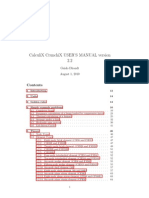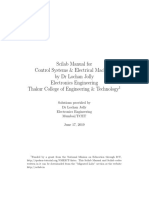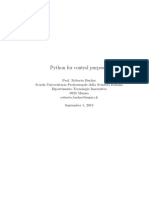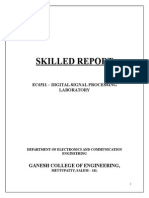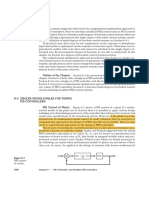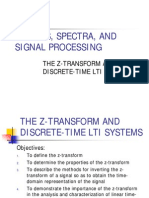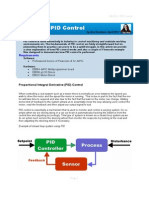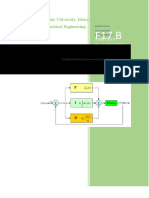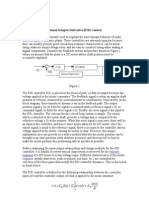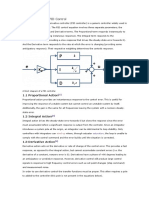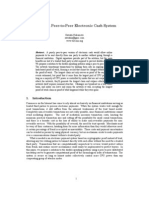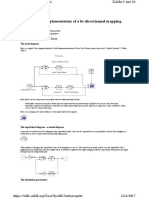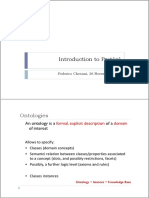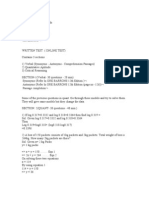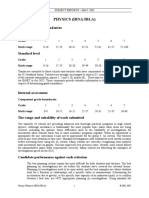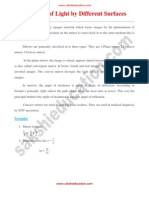Module 4: PID Control | Scilab Ninja
1 13
Scilab Ninja
Control Engineering with Scilab
Module 4: PID Control
Tweet
Like
Share
Share
Module 4: PID Control
This article is contained in Scilab Control Engineering Basics study module, which is used as course material
for International Undergraduate Program in Electrical-Mechanical Manufacturing Engineering, Department of
Mechanical Engineering, Kasetsart University.
Module Key Study Points
understand the basics of PID control
learn the effects of 3 parameters to system response
learn how response is degraded by integrator windup
How to tune PID parameters by Ziegler-Nichols Frequency Domain method
PID stands for Proportional, Integral, and Derivative. It is a standard control structure used successfully in
many industrial applications. Commercial PID controllers can be bought off the shelf and installed in the
system. After some setup and tuning the three PID gains, and perhaps some additional parameters, the system
is up and running in no time. Of course, this means the control engineer is certain the plant can be handled by
the PID controller and understand how to adjust the control parameters. Without such knowledge, it could be
a frustrating experience to her.
So, in this module we discuss some basics of PID control and focus on how to analyze a feedback sysem, with
Scilab, build an Xcos diagram and simulate. For a detailed study, we recommend [1]. For those interested in
digital PID implementation, document [3] on this site might be helpful. The e-book [4] provides more
information on independent robot joint control using PID.
Different forms of PID
The so-called textbook form of PID controller is described as follows
(1)
http://scilab.ninja/study-modules/scilab-control-engineering-basics/mod... 11/11/2016
�Module 4: PID Control | Scilab Ninja
2 13
This algorithm computes the control variable
as output, given the input , the error between the command
and plant output. We see that the control variable is a function of 3 terms: P (proportional to error), I (time
integral of error), and D (derivative of error), with corresponding control parameters
(integral time), and
(proportional gain),
(derivative time), respectively. Taking Laplace transform of (1), we have
(2)
with the transfer function of PID controller
(3)
Another common structure of PID algorithm is represented by
(4)
In this form, the controller gains are distributed to each of the PID terms separately, with its transfer function
(5)
For our discussion of PID controller, we focus on the form (4) and (5). Nevertheless, it is easy to convert
between parameters of (1) and (4) by the relations
(6)
Ex. 1: To get started with Xcos simulation of a PID feedback system, download file pid_feedback.zcos . This
launches an Xcos diagram in Figure 1. This diagram can easily be constructed using Xcos standard palettes. It
requires only a step_function, clock_c (from Sources palette), PID and CLR blocks (from Continuous time
systems palette), SUMMATION (from Mathematical operations palette), MUX (from Signal Routing palette),
and CSCOPE (from Sinks palette). The plant transfer function is a robot joint driven by DC motor model
from module 1, with
and
http://scilab.ninja/study-modules/scilab-control-engineering-basics/mod... 11/11/2016
�Module 4: PID Control | Scilab Ninja
3 13
Figure 1 pid_feedback.zcos basic PID simulation diagram
Click on the Simulation Start button to see the step response. Try adjusting the PID gains and plant
parameters to see their effects on the closed-loop system.
PID parameter tuning is well studied in control engineering. Here we give a brief guideline. The proportional
gain
is a dominant quantity that normally has some nonzero value. The integral gain
helps eliminate
steady state error but too high value could introduce overshoot and oscillation. The derivative gain
could
help the response to reach steady state faster but could amplify high frequency noise, and could affect stability
if set too high.
When the plant model is not known, adjusting these 3 gains to achieve good response could be problematic
for an inexperienced user. Later we discuss a tuning procedure. Commercial PID controller products usually
have auto-tuning functions for user convenience.
Ex. 2: To experiment with the tracking and disturbance attenuation performance of PID control, we setup a
feedback diagram in Figure 2.
Figure 2 PID feedback diagram
http://scilab.ninja/study-modules/scilab-control-engineering-basics/mod... 11/11/2016
�Module 4: PID Control | Scilab Ninja
4 13
which can be constructed as an Xcos model pid_dist.zcos in Figure 3. The joint inertia and friction are set to
and
, respectively. The step disturbance at the plant input is active at t = 2 sec, with step
value of 80.
Figure 3 pid_dist.zcos Xcos model for PID feedback with disturbance
Note that in this example, we have the luxury of knowing the exact plant model. So it is possible to solve for a
good set of PID gains. An approach used in [2] turns off the
gain first and solve for
yields a critical-damped system at chosen natural frequency. Then
and
that
is adjusted to eliminate steady-state
error.
To elaborate, it is shown in [2] that when
is set to 0, the resulting second order closed-loop characteristic
polynomial is described by
(7)
which gives
(8)
For example, suppose we select a critical-damped closed loop system
. From (8), this yields
and
, with natural frequency
. Table 1 below gives calculated P and D gain
values for 3 selected natural frequencies.
160
80
640
160
12
1440
240
Table 1
and
gains for 3 different natural frequencies
Using these 3 sets of gain values, we simulate the step responses. The results are shown in Figure 4. As
expected, the higher the natural frequency, the faster the response. We also see that the steady-state error from
step disturbance cannot be eliminated with the PD controller.
http://scilab.ninja/study-modules/scilab-control-engineering-basics/mod... 11/11/2016
�Module 4: PID Control | Scilab Ninja
5 13
Figure 4 step responses of PD control with disturbance d = 80
To fix this problem, we need to turn on the
gain of PID controller. With the controller transfer function
described by (5), the closed-loop system is now of third order
(9)
with the characteristic polynomial
(10)
Applying Routh-Hurwitz criteria to (10), it can be concluded that, given all positive PID gains, the feedback
system is stable if
(11)
The same Xcos diagram in Figure 3 can be used by putting some positive integral gain in the PID block. Let
us fix
and
, corresponding to natural frequency
the responses from setting some values of
is eliminated by increasing
rad/s. Figure 5 shows
. We see that the steady-state error to command and disturbance
, though higher value could introduce more overshoot.
http://scilab.ninja/study-modules/scilab-control-engineering-basics/mod... 11/11/2016
�Module 4: PID Control | Scilab Ninja
6 13
Figure 5 step responses of PID control
Applying the bound (11) to this example yields
This can be verified by setting
. The oscillating response in Figure 6 shows that the closed-
loop system is at the brink of stability.
Figure 6 closed-loop response at controller gains
Effect from Saturation
Analysis of PID feedback control is often performed under the assumption that the system is purely linear. In
real devices, nonlinear elements emerge at certain points in the feedback loop. Saturation is one of them that
could cause undesirable system response. This nonlinear effect normally results from physical limits of
http://scilab.ninja/study-modules/scilab-control-engineering-basics/mod... 11/11/2016
�Module 4: PID Control | Scilab Ninja
7 13
signals and system parameters, say, maximum motor torque and current. Another common saturation is the
input limit of servo amplifier. An industrial servo amp might allow input voltage command in the range
volts, for example.
Effect from saturation is more pronounced when integral term is used in PID. The response could have
excessive overshoot due to error accumulation in the integral term. This is known as integrator windup. See
[1] for more detail.
Ex. 3: To see an effect from input saturation, construct an Xcos model as in Figure 7, or download
pid_ilim.zcos. It represents a comparison of two closed-loop systems, which are basically the same except
that the lower one has its input bounded between
units.
Figure 7 pid_ilim.zcos Xcos diagram for Example 3
The controller gains are set at
. Running the simulation yields
the step responses in Figure 8, and the control variables (controller output) in Figure 9. We see that input
saturation causes significantly larger overshoot and also worsens disturbance response.
Figure 8 effect of integrator windup on output response
http://scilab.ninja/study-modules/scilab-control-engineering-basics/mod... 11/11/2016
�Module 4: PID Control | Scilab Ninja
8 13
Figure 9 controller output with plant input limit
Tuning the PID Parameters
As stated before, adjusting the PID gains from scratch to achieve a good response may not be trivial. As a
result, most commercial PID controllers have functions to tune the 3 parameters automatically. This is
normally called autotuning feature. One of autotuning methods suggested in the literature makes use of
some relay feedback mechanisms, which is closely related to a manual tuning scheme known as ZieglerNichols Frequency Domain (ZNFD) method. Hence we discuss this ZNFD scheme in the last part of this
module.
Note: The original ZNFD method applies the textbook PID equation (1). But since (1) and (4) are closelyrelated by (6), here we make a conversion so that standard PID block in Xcos, which assumes the form (4),
can be conveniently used.
To tune a PID controller manually by ZNFD method, follow this procedure
turn off both the integral and derivative terms; i.e., setting
with the proportional gain
. We crank
. So now the PID is left only
up to the point that the closed-loop system starts to oscillate.
At this point, the plant output will swing in a constant sinusoid motion, not growing and not dying out.
Write this value down on a paper as
.
Measure the period of oscillation. Write it down as
Use Table 2 to tune the controller parameters
Controller
Form
P
PI
PID
Table 2: suggested PID parameters from ZNFD method
http://scilab.ninja/study-modules/scilab-control-engineering-basics/mod... 11/11/2016
�Module 4: PID Control | Scilab Ninja
9 13
From the above procedure, we could observe a drawback of the basic ZNFD method: the system must
oscillate at some point of gain setting before it becomes unstable. This implies the Nyquist plot must cross the
negative real axis at some point. For the DC motor model we are using, the gain margin is infinity. Hence it is
difficult to find the oscillating point and the
value.
There is some trick to get around such limitation, but this is beyond the scope of this module. For our basic
study, we simply modify the DC motor robot joint by adding some dynamics to it, so that the Nyquis plot of
crosses the negative real axis.
Ex. 4: Let us assume that the PID output is passed through a LPF with cutoff frequency 500 Hz before
feeding the plant input. Using the filter design guide from module 1, we have the LPF transfer function as
(12)
To simulate, construct an Xcos model in Figure 10, or download pid_znfd.zcos. With this model, we are
ready to perform the ZNFD tuning procedure described above. Click on the PID block to set the I and D gains
to zero. Then start increasing the P gain until the output oscillates. This is what you must do in a real
application when the plant model is not known.
Figure 10 pid_znfd.zcos Xcos diagram for ZNFD tuning method
Well, in this example we do know the plant model, dont we? So, to save us some time, the
value that
causes output oscillation can be found, for example, using the method from Module 2. First from the loop
transfer function containing the plant, LPF, and PID controller with
-->kp = 1;
-->ki = 0;
-->kd = 0;
-->s=poly(0,'s');
-->P=syslin('c',1/(10*s^2+0.1*s));
-->H = syslin('c',1/(1+0.0003*s));
-->C=syslin('c',kp + ki/s + kd*s);
-->L = C*H*P; // loop t.f
// plant
// filter
// controller
Then find the gain where the closed-loop pole touches the
axis.
->[kmax,s]=kpure(L)
s =
5.7735027i
http://scilab.ninja/study-modules/scilab-control-engineering-basics/mod... 11/11/2016
�Module 4: PID Control | Scilab Ninja
10 13
kmax =
333.33433
resulting in
Verify this by setting the P gain to 333 in PID block. This yields the desired oscillatory response as shown in
Figure 11. The oscillation period can be roughly measured from the plot to yield
sec.
Figure 11 oscillatory response with
So from the last row of Table 2, ZNFD method suggests the three PID parameters as
Setting these gains gives the response in Figure 12.
Figure 12 response from PID gains suggested by ZNFD method
Note that the overshoot is quite excessive (70%). In a sense, ZNFD just gives us some good values to start
with. We may want to fine-tune the PID gains to improve the response further. For example, decreasing the
http://scilab.ninja/study-modules/scilab-control-engineering-basics/mod... 11/11/2016
�Module 4: PID Control | Scilab Ninja
11 13
Ki gain would bring the overshoot down. Figure 13 shows the response from original PID gains (green),
compared with the case when Ki is reduced to 300 (blue), and 200 (magenta).
Figure 13 reduce overshoot in the response by decreasing
The ZNFD method could be explained using a Nyquist diagram in Figure 14. The diagram shows how a point
on the curve is moved related to the P, I , and D terms. Using the P term alone, x could be moved in radial
direction only. The I and D terms help provide more freedom to move perpendicular to the radius. It can be
shown that by using ZNFD method, the critical point
is moved to the point
The distance of this point to the critical point is 0.5. So the sensitivity peak is at least 2. This explains the high
overshoot in the step response.
http://scilab.ninja/study-modules/scilab-control-engineering-basics/mod... 11/11/2016
�Module 4: PID Control | Scilab Ninja
12 13
Figure 14 How a point on Nyquist curve is moved with PID control
Summary
PID is a simple control structure that is still used widely in various industrial applications. It is a close relative
to the lead-lag compensator explained in module 2, except that its functionality may be more user-friendly.
With some knowledge and practice, an engineer or technician would be able to tune and operate a plant
equipped with PID control.
In this module we discuss the basics of PID feedback systems, with emphasis on Xcos simulations to show
how the responses are related to three control parameters, as well as effect from input saturation that could
worsen the response. Without some good starting values, tuning the PID gains can be cumbersome for a
novice. So at the end, we mention a manual tuning procedure known as the Ziegler-Nichols frequency domain
method. Some auto-tuning scheme of a commercial PID controller, such as the relay feedback method, is
based on the ZNFD manual tuning.
References
1. K.J. Astrom and T.Hagglund. PID Controllers, 2nd ed., Instrument Society of America, 1995.
2. M.W.Spong, S. Hutchinson and M. Vidyasagar, Robot Modeling and Control. John Wiley & Sons. 2006.
3. V. Toochinda. Digital PID Controllers, a previous online document available at controlsystemslab.com.
2009.
4. V.Toochinda. Robot Analysis and Control with Scilab and RTSX. Mushin Dynamics, 2014.
Comments
Module 4: PID Control 2 Comments
Pingback: Discrete-time PID Controller Implementation | Scilab Ninja
http://scilab.ninja/study-modules/scilab-control-engineering-basics/mod... 11/11/2016
�Module 4: PID Control | Scilab Ninja
13 13
Pingback: PID Links | Control Systems Lab
http://scilab.ninja/study-modules/scilab-control-engineering-basics/mod... 11/11/2016






